India
Bombay/Mumbai November 17-21
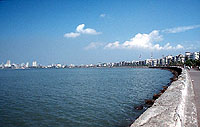 Going from Udaipur to Bombay (now renamed
as Mumbai) is like going from the farm
to the big city. Bombay pulses like New
York City, but looks a bit like Los Angeles
or London, for that matter (the Brits left
a wonderful architectural heritage here).
It actually sits on an island, similar
to Manhattan Island of New York City.
Going from Udaipur to Bombay (now renamed
as Mumbai) is like going from the farm
to the big city. Bombay pulses like New
York City, but looks a bit like Los Angeles
or London, for that matter (the Brits left
a wonderful architectural heritage here).
It actually sits on an island, similar
to Manhattan Island of New York City.
From the moment I stepped off the plane I could tell that Bombay was the most western of India's cities, and I also noticed the intense heat and humidity. Think of an East Coast US City like Boston, New York or Washington DC in the most uncomfortable heat spell in July, and that's Bombay!
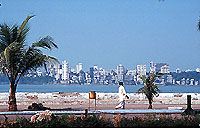 Fortunately I booked a hotel on Marine Drive,
which borders on the Arabian Sea (or Indian
Ocean, don't know where one begins and one
ends). Looking down Marine drive, with its
condos, hotels and palm tree, you could swear
that you are on the Pacific Coast highway
in Santa Monica or Collins Ave in Miami Beach
(except if you look a little closer, all the
condos are mold laced and in serious need of
a paint job, like 99.9% of the other buildings
in India). Looking down the semicircular
coastline, one can see Malabar Hill, an
Indian yuppie area containing the most
expensive real estate in the world. Bet you
didn't know that!
Fortunately I booked a hotel on Marine Drive,
which borders on the Arabian Sea (or Indian
Ocean, don't know where one begins and one
ends). Looking down Marine drive, with its
condos, hotels and palm tree, you could swear
that you are on the Pacific Coast highway
in Santa Monica or Collins Ave in Miami Beach
(except if you look a little closer, all the
condos are mold laced and in serious need of
a paint job, like 99.9% of the other buildings
in India). Looking down the semicircular
coastline, one can see Malabar Hill, an
Indian yuppie area containing the most
expensive real estate in the world. Bet you
didn't know that!
Bombay is huge, 18 million people, and growing as scores of poor people pour into the city, hearing of its wealth. But I am located in a spot where there are western restaurants, and even a Bank of America branch! The women dress mostly western and are by far the best looking in India, IMO. But the beggars are the most aggressive and annoying so far.
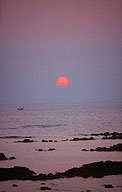 Despite its commercial character, there
holds a number of spiritual venues on my
list, such as Karve Guruji, an astologer/
psychic/healer who fame is growing worldwide,
Ramesh Balzekar, an Advatic teacher in the
school of Nisargadatta Maharaj (he woke up
one day while translating one of Nisargadatta's
talks), and the samadhi (burial) sites of
Swami Muktananda, his Guru Bhagwhan Nityananda,
and Shirdi Sai Baba, one of the most beloved
gurus in India this century.
Despite its commercial character, there
holds a number of spiritual venues on my
list, such as Karve Guruji, an astologer/
psychic/healer who fame is growing worldwide,
Ramesh Balzekar, an Advatic teacher in the
school of Nisargadatta Maharaj (he woke up
one day while translating one of Nisargadatta's
talks), and the samadhi (burial) sites of
Swami Muktananda, his Guru Bhagwhan Nityananda,
and Shirdi Sai Baba, one of the most beloved
gurus in India this century.
Karve Guruji
Karve Guruji is a man of many talents, an astrologer, a psychic, a healer, and to many people their Guru. I was told of Karveji by a friend and fellow Vedic astrologer, who told me that Karve is a must see in India. As luck would have it, I called to see him on only one of two days he would be in Bombay for a while. I got through to the place where he was staying around 3:30, and the person says, bring your chart and come over right away.
So I grab a cab, fight with the driver over the charge, and I'm off, on my first day in Bombay to see this extraordinary man. He is staying in the Kurla east area of Bombay and on the way I see miles of the shanty towns that Bombay is also famous for. With my money and western lifestyle, I feel so priveledged - there must be so much despair in this towns, but then perhaps I shouldn't rush to judgment and lay my ethnocentric values on these people. On the other hand poverty is poverty, and it is staggering beyond your imagination here in India.
When I arrive, after going up an extra filthy hallway (it just blows my mind!). I reach Karve's room, and soon discover that I'm not gonna have a one-on-one, it is more of a satsang venue, with many people coming to see him after work. While standing in the doorway, Karve sees me and asks me to sit down right near him, another white-guy from the west special priveledge - I got to cut ahead of many people.
Many people were there to have certain problems worked on by Karve, others are just there apparently just to hang, and since the whole thing is in Hindi, I'm thinking, "Toto, we're not Kansas anymore!" - I feel a bit self-conscious and can't figure what the hell is going on. Karve seems to work in Indian chaotic fashion, answering the phone and doing phone work in the midst of working on a person, but it seems ok.
Karve is one of those saintly people that you've may have read about - someone who is partly here, partly in communication with some inner state, like he's gonna faint like Ramakrishna any minute. But he is also right there with people at the same time, in a very soft way.
Karve's forte is one to readjust people's birth time using psychic means. Now the skeptic in me can scream bloody murder, but when he worked with me, he told me my birth time was one minute off. But what was amazing, and this is not psychic, but based on a lifetime of studying astrology, people tell him where each house each planet is in, and then he tells you the year, month, day, hour and minute you were born. To an student of astrology, that is amazing.
Sitting there, I felt the top of my head was being blasted wide open in an ascending spiritual current, which gave me an insight into his kind of gifts. He seems to be a man bound for the yellow or blue realms of the cosmic mandala. Through an interpreter, he told me a number of things about me and my wife's past, present and future, which is not worth saying here, but suffice to say, if you have had a chart done, and he comes to your town, especially when he tours on the east coast of the US, you may be given useful information that you'll not receive otherwise.
Ramesh Balzekar
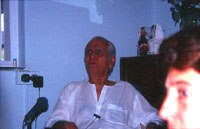 Ramesh Balzekar had a tremendous influence
in my spiritual life via his most famous
book, a compilation of talks call Consciousness
Speaks. Sometimes a catalyst in your spiritual
process may come through a non-human form,
and Consciousness Speaks was such a catalyst
for me - it came at a time in my life when
I was, by some grace, ready, and the book
took on a transmittive power in my life,
leading me to very extraordinary experiences,
such as formless samadhi in 1994. To say
that Guru can come in the form of a book,
flower, child, etc., can be so cliche and
so superficial, but this particular book
was the case for me.
Ramesh Balzekar had a tremendous influence
in my spiritual life via his most famous
book, a compilation of talks call Consciousness
Speaks. Sometimes a catalyst in your spiritual
process may come through a non-human form,
and Consciousness Speaks was such a catalyst
for me - it came at a time in my life when
I was, by some grace, ready, and the book
took on a transmittive power in my life,
leading me to very extraordinary experiences,
such as formless samadhi in 1994. To say
that Guru can come in the form of a book,
flower, child, etc., can be so cliche and
so superficial, but this particular book
was the case for me.
But since that time, I've felt that I've really got the message of Advaita Vedanta in my bones, to the point where listening to Advaitic talks can become painful. So it was with mixed emotions that I went to see Ramesh this day, located in one of the more affluent neighborhoods in Bombay (but nevertheless, the hallways of the building were still dirty!).
Ramesh being a former Vice President of some bank, has an entire floor of his building to himself, so satsang at his home is most convenient. The small living room and large adjoining porch was filled with mostly westerners, as I expected, but there were a significant number of Indian devotees around.
The years have treated Ramesh well, and he speaks with a youthful exuberance which is quite enchanting. He repeats many of his central tenets quite often, which doesn't mean that people are getting it - as he says, the total acceptance that you are not the doer, nor an individual "entity" inside a body, can only occur by grace or chance, and it is not in control of the aspiring student. He uses some theistic themes in his talk, using "Thy will be done" in a way to emphasize the impersonal nature of existence, which is a neat twist.
However, to be honest, his talk did wear on my after a while, and I did want to challenge him on some points, but I'm here for one time and it's not worth it. He ends his satsang with a half hour of singing, some English songs, and some Indian bhajans, which surprised me. At the end, many people leave by doing a pranam to his feet, and Ramesh blesses them, which I found surprising - the level of devotion to Ramesh by his Indian and western students. It was actually refreshing and juicy - as you may know, Advatic talks can become quite tedious and dry. In any case, it was enjoyable to see Ramesh Balzekar, an authentic Advaitic teacher and a link to Nisragadatta Maharaj, and if you're ever in Bombay, I'd recommend you go to satsang with Ramesh, but sooner than later, he's getting on in years. There is another teacher nearby, an associate of Nisargadatta Maharaj named Ranjeet Maharaj, who has begun teaching at the age of 80(!), and I have info for his satsangs if you're interested.
Ganeshpuri: Muktananda, Nityananda
Many months ago, when I was setting up this journey, a friend said to me, "since you were a devotee of Adi Da, you may want to investigate his teachers and lineage" - this meant going to the samadhi sites of the famous Swami Muktananda, his Guru Bhagwan Nityananda, of huge belly, and Shirdi Sai Baba.
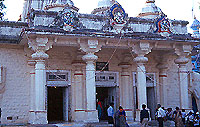 For several reasons I decided not to go
to Shirdi Sai Baba's gravesite, but the
Muktananda ashram is in Ganeshpuri, an
outlying suburban/rural town of Bombay,
about 60 miles from town.
For several reasons I decided not to go
to Shirdi Sai Baba's gravesite, but the
Muktananda ashram is in Ganeshpuri, an
outlying suburban/rural town of Bombay,
about 60 miles from town.
After getting some info from the Gov't of India Tourist Office, I decided to do the whole trip to Ganeshpuri (as well as my next stop, the city of Bangalore) all by myself, sans travel agent, which was stretching the limits of my experience.
So I purchased a second class commuter train ticket from the downtown Churchgate train station, and got my first experience of second class existence on India's huge train system. It definitely was an experience in itself, especially the return trip at late rush hour - at each station the newly arriving play this comical game of musical chairs, rushing to find an open seat. And a bench for three takes four people in this realm. At times it was sardine city, and I could just imagine what it is like when the temperature is really hot out in the summer. The trains have special ladies compartments, since I wouldn't want to subject the smaller women to the free-for-all madness that can go on, and I don't think they'd like to be squeezed up against strange men.
So I arrived at the Vasai Road train station, by some miracle, and negotiated with a rickshaw driver for the 30 km trip to Ganeshpuri. I bargained hard and only slightly got ripped off ( 160 vs 120 rupees, 4 vs 3 US$).
After an hour's bumpy ride along two lane roads and one of those big Indian "highways", I reached the entrance of the Muktananda Ashram, which is now in the control of his successor, GuruMai (Chidvilasananda), a young woman with an eye for good clothing, which makes sense now, being so close to Mumbai. That whole organization is a whole other story, and suffice to say, I wanted to avoid their numbers while I spent time at the samadhi sites.
But as soon as I got to the Muktananda ashram, I had to "check" in with reception, which seemed way too over-oganized, especially for India. When I told the woman I simply wanted to visit the samadhi sites, there was a kind of "well, this is most highly irregular!" response, and they sent for a guide. But I could go in on my own. The inside of the compound/ashram was extraordinarily well kept and beautiful. And there were lots of westerners around doing a one month mimimum retreat stay.
I stopped by a life sized brass statue of Bhagwan Nityananda before entering Swami Muktananda's samadhi site next door. It was a 30 foot square room with the large white marble crypt of Muktananda in the center. A rare occurance, I noticed people meditating in the hall, women on the left side, men on the right, as customary in the Muktananda (as well as other) sangha - at least this time I won't be so out of place meditating at a sacred site! A large picture of Muktananda hang at far end of the room.
I circumambulated the crypt three times as customary in India, and sat down (first on the womens' side...oops!) to meditate. Muktananda, was a devout Shavite (devotee of Lord Shiva) and there are numerous pictures of him with the horizontal markings on the forehead. And as I sat there, I could feel the "in your face" kind of force that is reminiscent of Shiva, but not of the ascending Kundalini force that Muktananda could also dish out in 'shaktipat' sessions. It was joyful to sit as long as I wished in the site, and could feel the force of the place quite easily. Many devotees came in for a blessing, both Hindi and western, kissing a small paduka statue in front of the crypt.
I spent about a half an hour in the samadhi site hall and was markedly changed by the time (hey, after an hour on an Indian train, it could only get better!). Right across the samadhi site in the compound was the hall that held numerous satsangs for many, many years. I was reminded of the story of my former teacher, Adi Da, when he first came to Muktananda's ashram and thought of how much history that hall must hold.
The guide that was dispatched finally caught up with me, and she began going through the 'talk', but was shooshed by a guard, since you're supposed to keep total silence on the ashram compound. I made it gracefully clear that I had no intention of having anything to do with GuruMai and her organization, and she was impressed by the fact that I visited Muktananda is his South Fallsburg, NY ashram in 1974, which was probably before she was born! So she kindly showed me the door, not because I was rude or anything, but because the Bhagwan Nityananda site was actually in another town, Ganeshpuri, 1 km down the road.
Walking to Ganeshpuri, I felt totally unattached and alone - I had no cab or guide waiting for me, just the Bombay commuter rail system as my way home. But I felt comfortable at the same time, as this was a place that was used to westerners, and I did not get that extra heavy stare that I often get going to sacred sites.
As I approached Ganeshpuri, I could hear a public address system of a chanting session in one of the numerous ashrams in town. There are actually several samadhi sites in Ganeshpuri besides Bhagwan Nityananda, but I have no idea who these men were! The samadhi site lies at the south end of town, marked by a beautiful three story high spire that is reminsicent of so many temples in India. A map my friend gave me came in very handy at the moment, and I was able to find my way to the samadhi site quite easily.
I immediately noticed that it was a Happy place - I can't think of another adjective that is more descriptive, it is just a Happy place, a loka of happiness. As I approached the shrine, several hundred school children preceeded me into the building, and I noticed it had a very open kind of architecture, which I thought could diminish the vibe. I waited for the kids to amscray and vamoose from the scene before I entered.
The shrine is a 200 foot long hall with at 20 by 20 altar up front containing a hexagon shaped burial crypt of Bhagwan Nityananda. On top of the crypt is a beautiful life-size gold/brass replica of Nityananda seated with a small umbrella over him. So I received some prasad from the temple priest, and stood to the side as several families came through to receive a blessing. All small children were handed over to the priest so that he could touch the child's forehead to Nityananda's form, and one child made it clear she did not being held by the priest!
As I sat there, I waited for something to happen, but felt nothing, which surprised me. I seem to have a sensitivity to spiritual currents, but certainly I could be somewhat out of balanced, or dense, or perhaps the place wasn't potent.
Suddenly feeling a bit tired, I moved behind the altar railing to sit in the large hall area, and then it became clear to me what kind of place this was. As I meditated there, I came in contact with a very deep, blissful current moving down the front of my body, opening up my naval chakra area (of course Nityananda is famous for his huge belly). I found myself moving into a deep state, past sleep, though I may have nodded for a few moments, but basically it was quickly to the 'theta' state. I was deeply happy, and when I finished meditating and looked around, there was a old man sitting next to me, giving me a major namaste with his hands. Now, being an experienced India traveller, I wondered if this was sincere or some baloney gesture to separate me from my rupees. But he didn't bother me afterwards.
I recognized that the current at the Bhagwan Nityananda site was completely different than Muktananda. Muktananda was his devotee, but as the story goes, he was initiated twice by Nityananda, once as a young man, and then 30 years later. It turns out that at first he wasn't ready to receive what Nityananda had to offer, so he wandered as a Shavite sadhu for 30 years before returning to Nityananda, and this time he was ready! So Muktananda stands apart from Nityananda, as least according to what I felt, not better or worse, just different, affecting one through different subtle pathways.
I approached the altar again and received some holy water, and the priest really warmed up to me. If you sit at a site, perhaps they see that you may be a practitioner, and not just some tourist or exoteric follower. So he asked me where I'm from, how did I know about Nityananda, etc, and gave me the red kum-kum mark to the third eye.
I walked around the large open compound of Nityananda shrine, with its streets full of schlocky spiritual paraphenalia and small restaurants. And I was seated in that deep happy place that Nityananda seemed to represent in the transmission at his site. Again, the people seemed happy and content, and it felt like a real Loka, a special place that really touched my heart. If I ever come back to India again, I would come back here.
Returning home was a bit more hellish than coming, as I hit late Friday night rush hour. There's something spooky and insane when you enter an intense scene such as a train station when it is getting dark - the caucaphony of energy is more chaotic and scattered than any other place I've ever been to, and the lack of light just accentuates it. Even the cab drivers have told me that they don't like driving at night - the chaotic lack of order is really dangerous.
November 21
As I felt a little sick again, I took it a bit easy but did get together with a cab driver who took me to several tourist sites of Bombay. He asks me if I have any kids, and I say no, and he says I'm lucky, he has four children age 10-18, and he has to work 7 days a week to feed them. He says his only day off is when he gets sick. He looks real tired.
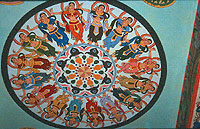 I went to yet another Jain temple, but
this time they allowed picture taking!
Jains believe temple building are an
act of devotion, so they are particularly
ornate one way or another. This one was
ornate in terms of having the walls
and ceiling equisitely painted in detail.
And there were some white marble carving
but nothing in comparison to the Mt.
Abu temples.
I went to yet another Jain temple, but
this time they allowed picture taking!
Jains believe temple building are an
act of devotion, so they are particularly
ornate one way or another. This one was
ornate in terms of having the walls
and ceiling equisitely painted in detail.
And there were some white marble carving
but nothing in comparison to the Mt.
Abu temples.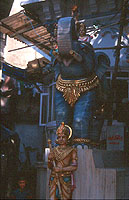
I also was taken to Mani Bhavan, a home that Mahatma Gandhi used quite often in his struggle to free India of the British. Looking over the pictures of Gandhi throughout his years, I was again emotionally moved by him. His one-pointed devotion to freedom really touches me, especially the way he did it. It was very moving.
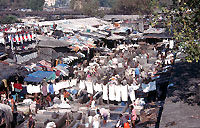 I also saw one of the most unique places
in all the world, the 'dobi-ghats'. Each
day, laundry from all over Bombay ends
up in this area, a place of hundreds
if not thousands of concrete tanks,
tubs and barrels, each operated by
a 'dobiwallah', thrashing the clothing
clean in sadistic style. The miracle
is that the clothes return to the
original owner with little loss,
better than most laundromats.
I also saw one of the most unique places
in all the world, the 'dobi-ghats'. Each
day, laundry from all over Bombay ends
up in this area, a place of hundreds
if not thousands of concrete tanks,
tubs and barrels, each operated by
a 'dobiwallah', thrashing the clothing
clean in sadistic style. The miracle
is that the clothes return to the
original owner with little loss,
better than most laundromats.
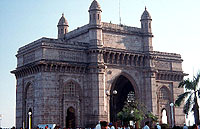 On the way to India Gate, my driver
took me through the red-light district
of Mumbai, on Falkland Road. There
were numerous men dressed up in drag,
and scores of young girls, heavily
made up, standing in doorways, looking
for business. It looked like a poor
person's Amsterdam, who's red-light
district is world famous. My driver
told me that each night there are
about 20.000 women doing business
in this area, to give you an
idea of the enormity of the sex
business here. It is said that Bombay
actually surpasses Bangkok in this
area, but except for Falkland road
it is all very much out of sight.
And which country has the most cases
of AIDs in the world? India. (well,
with nearly a billion people, it
probably has the most of every
category!).
On the way to India Gate, my driver
took me through the red-light district
of Mumbai, on Falkland Road. There
were numerous men dressed up in drag,
and scores of young girls, heavily
made up, standing in doorways, looking
for business. It looked like a poor
person's Amsterdam, who's red-light
district is world famous. My driver
told me that each night there are
about 20.000 women doing business
in this area, to give you an
idea of the enormity of the sex
business here. It is said that Bombay
actually surpasses Bangkok in this
area, but except for Falkland road
it is all very much out of sight.
And which country has the most cases
of AIDs in the world? India. (well,
with nearly a billion people, it
probably has the most of every
category!).
 The last item on the agenda was
India Gate, a large Arch de' Triumph
like structure on the east side of
Mumbai. It is at this place where the
last British troops left, marking
the beginning of Indian independence.
Across the street from India Gate
is the Taj Mahal hotel, a most
beautiful structure. Returning
to my hotel, I prepare myself
for the rest of my India journey
to South India, first stop Bangalore,
the 'silicon valley' of India, and
near to the 'avatar' Satya Sai Baba.
The last item on the agenda was
India Gate, a large Arch de' Triumph
like structure on the east side of
Mumbai. It is at this place where the
last British troops left, marking
the beginning of Indian independence.
Across the street from India Gate
is the Taj Mahal hotel, a most
beautiful structure. Returning
to my hotel, I prepare myself
for the rest of my India journey
to South India, first stop Bangalore,
the 'silicon valley' of India, and
near to the 'avatar' Satya Sai Baba.
 Back |
 Next, Bangalore and Sai Baba |
|
|
Page 12. |
||
